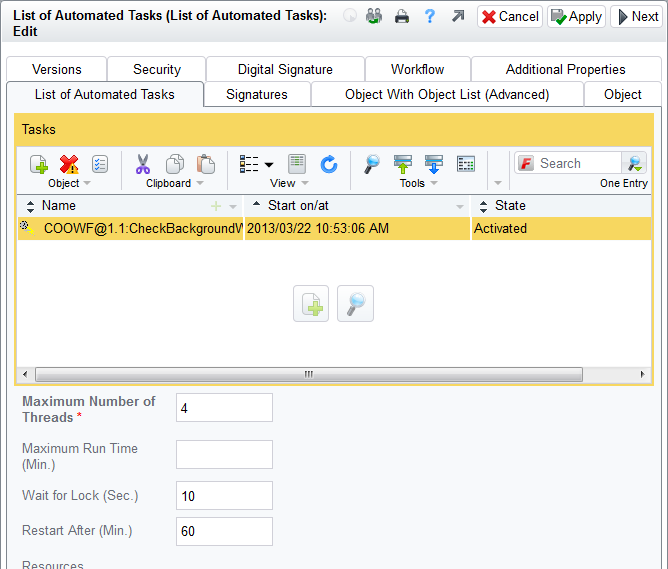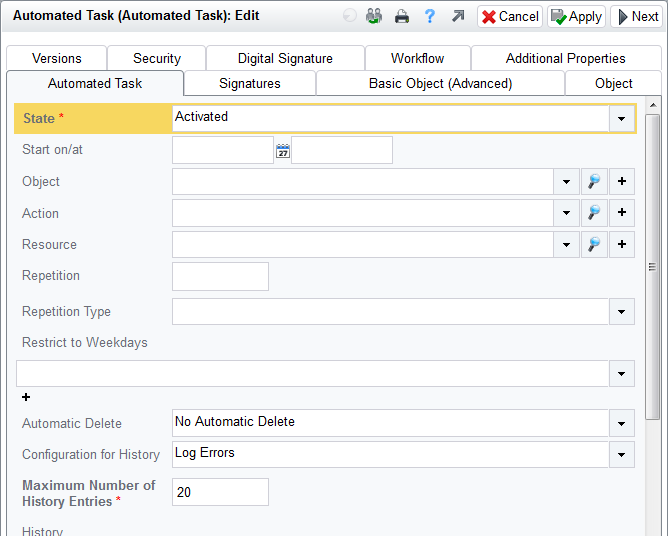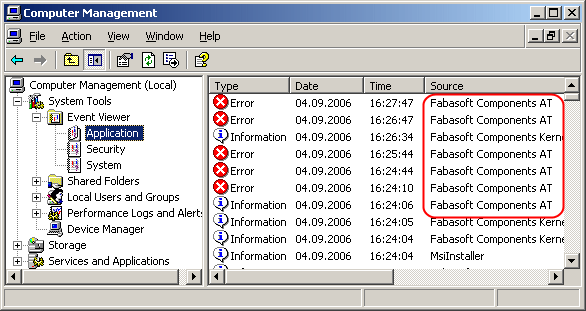Installation and Configuration of Fabasoft Folio AT Services
Preparing Operations
Each user who wants to process tasks in the background needs an own Fabasoft Folio AT Service.
Note: For processing background activities and waiting actions in the workflow (Fabasoft Folio/Wf software component) one Fabasoft Folio AT Service can be used for all users.
Excursion: Changing the User Context |
|---|
An action is processed in the security context of the user the Fabasoft Folio AT Service has been set up for. The Fabasoft Folio Kernel running in a Fabasoft Folio AT Service is able to change this user context. So for the workflow only one Fabasoft Folio AT Service dynamically changing the user context has to be set up. A user is allowed to change the user context if the user object is entered in the Privileged Users box of the Current Domain. The user in whose context the Fabasoft Folio AT Service is running, has to be entered as privileged user. Then activities can be processed by the Fabasoft Folio AT Service in the context of the user responsible for the activity. |
User Account
In the operating system environment, create a user account (e.g. fscatsrv) for each user in whose context a Fabasoft Folio AT Service will be running.
Note: Do not use the user account of the administrator to set up a Fabasoft Folio AT Service.
For this user, a user object has to be created in the Fabasoft Folio Domain.
Note: If the Fabasoft Folio AT Services are installed at the same computer as the Fabasoft Folio Backend Services and the same user is performing the installation, for the user in whose context a Fabasoft Folio AT Service will be running a user object is created automatically in the Fabasoft Folio Domain.
Launch Permission in Microsoft Windows
Each user, in whose context a Fabasoft Folio AT Service will be running, needs to have launch permissions for the “Fabasoft Folio AT Server“ application. To grant these permissions, perform the following steps:
- Open the “Component Services” MMC snap-in.
- Open “Component Services” > “Computers” > “My Computer” > “DCOM Config”, to display all available applications.
- Right-click “Fabasoft Folio AT Server” and then click “Properties“.

- Click the “Security” tab.
- Under Launch and Activation Permissions, select Customize and then click “Edit“.
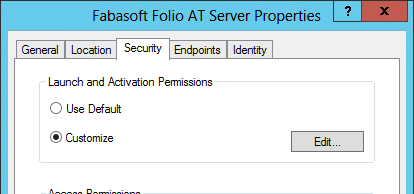
- Click “Add“, to add the user in whose context the Fabasoft Folio AT Service will be running to users in the Group or user names box.
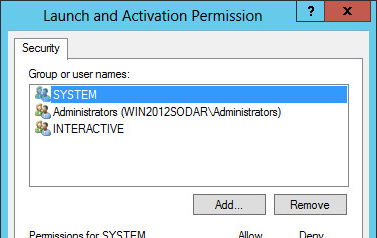
- In the Enter the object names to select box, type the user account in the context of which the Fabasoft Folio AT Service will be running and then click “OK“.
- In the Group or user names box, select the user in whose context the Fabasoft Folio AT Service will be running and in the Permissions for Administrators box, in the lines Local Launch and Local Activation select the Allow check box.
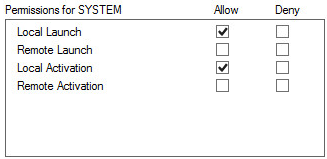
- In the “Launch Permission“ dialogue box and the “Fabasoft Folio AT Server Properties“ dialogue box click “OK“ and close the component services.
Installation of Fabasoft Folio AT Services
To install Fabasoft Folio AT Services via the automated setup, perform the following steps:
- Insert the Fabasoft product DVD in the DVD drive of your server. The Fabasoft Server Setup dialog will be displayed automatically.
Note: If this dialog is not displayed automatically, run setup.exe in the root directory of the Fabasoft product DVD. - Accept the Fabasoft legal terms and click “Next”.

- Select Typical as setup configuration template and then click “Next”.

- In the next dialog two options are available. Select Use an existing Fabasoft Folio Domain, in the Host field type the hostname of the Fabasoft Folio Backend Server, in the Port field type its port and click “Next”.
- Install a new Fabasoft Folio Domain
Select this option to install Fabasoft Folio Backend Services. In the License file field, type the path to the license file or click “Browse” to browse the file system. - Use an existing Fabasoft Folio Domain
Select this option to use an existing Fabasoft Folio backend installation.
- Install a new Fabasoft Folio Domain
- Select Fabasoft Folio AT Services, clear the checkboxes of all other services and click “Next”.
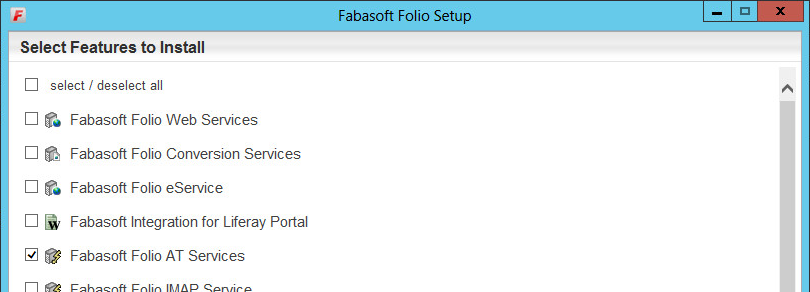
- A check on all prerequisites is performed. Its result is presented in an overview. Ensure that your system complies with all requirements (indicated by a green tick) and click “Next”.

- Type the Username and the Password of the user account that should be used for running the Fabasoft Folio AT Service in the corresponding fields and click “Next”.
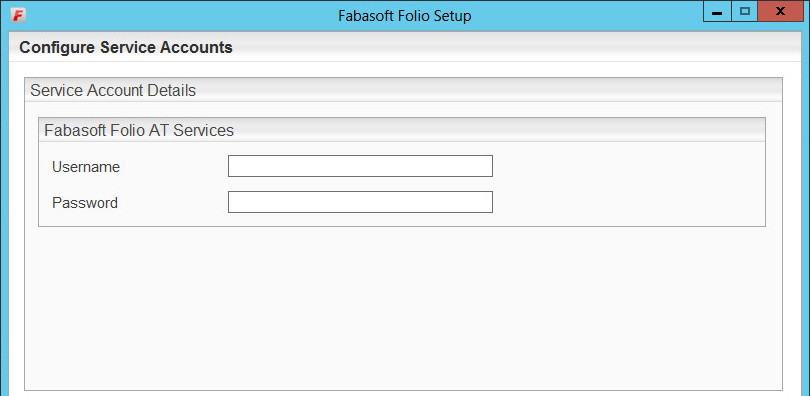
Note: This service user must exist as an operating system user and must have a corresponding user account in the Fabasoft Folio Domain. - In the Review Configuration, the Fabasoft Folio Services can be configured.
If you want to change the settings click “Edit” next to the Fabasoft Folio AT Services. Otherwise click “Install”. In this case the next steps can be omitted. - The following options are available to configure the Fabasoft Folio AT Services.
Create a Fabasoft Folio AT Service for each user who wants to perform automated tasks. The user accounts have to be created before the installation in the operating system environment. In the Fabasoft Folio Domain the user accounts are created automatically.
Note: For all automated tasks in the workflow only one Fabasoft Folio AT Service is needed.
Click the name of a Fabasoft Folio AT Service, to edit the settings.
In the Service name field the name of the Fabasoft Folio AT Service can be specified. Click “OK” to close this dialog.- A Fabasoft Folio AT Service can be edited by clicking the name of the service or by clicking “Edit”.
- A Fabasoft Folio AT Service can be deleted by clicking “Remove”.
- A Fabasoft Folio AT Service can be created by clicking plus icon.
- Click “OK”, to close the dialog for configuring the Fabasoft Folio AT Services.
- Click “Install” to start the installation.
The Fabasoft Folio AT Services are installed.
In the Fabasoft Folio Server Management navigate to “Fabasoft Folio” > “Computers” > “<computer name>”. The “Automatic Tasks” entry is available.

Create Further Fabasoft Folio AT Services
To create a Fabasoft Folio AT Service, perform the following steps:
- Run the “Fabasoft Folio Server Management”.
- Navigate to “Fabasoft Folio” > “Computers” > “<computer name>” > “Automatic Tasks”.
- Right-click “Automatic Tasks”, point to “New” and click “Service”.
The “Create Additional Service Wizard” dialog for creating the Fabasoft Folio AT Service is started. - Click “Next“.
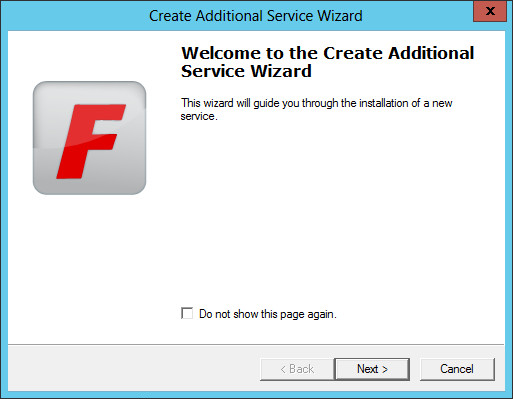
- Define the connection data to the primary Fabasoft Folio COO Store.
In the Server field type the hostname of the computer the primary Fabasoft Folio COO Store of the Fabasoft Folio Domain in located on. In the Port field type the port number of the primary Fabasoft Folio COO Store and click “Next“.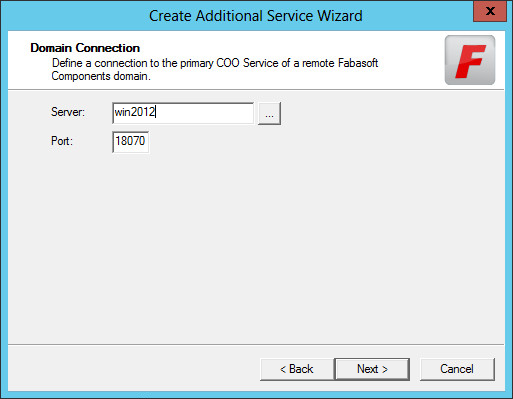
- To determine the user account in the context of which the Fabasoft Folio AT Service will be running (see chapter ”User Account”) two options are available. Select This account, type the user account data in the corresponding fields and click “Next”.
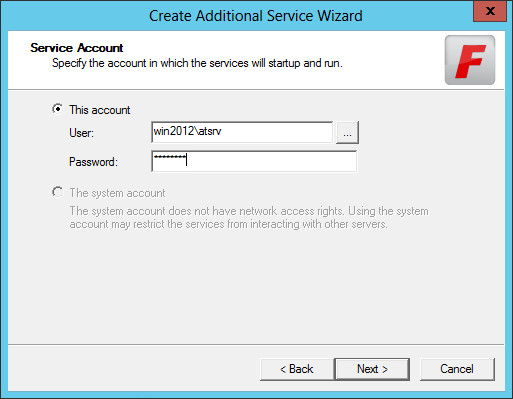
- This account
When selecting this option, in the corresponding boxes the user account data have to be typed.
Note: Click “…” to browse for the user account. - The system account
When selecting this option, the local system account is used for running the Fabasoft Folio AT Services. The local system account is a predefined local account that can start a service and provide the security context for that service.
- This account
- Type a name for the Fabasoft Folio AT Service and click ”Next“.
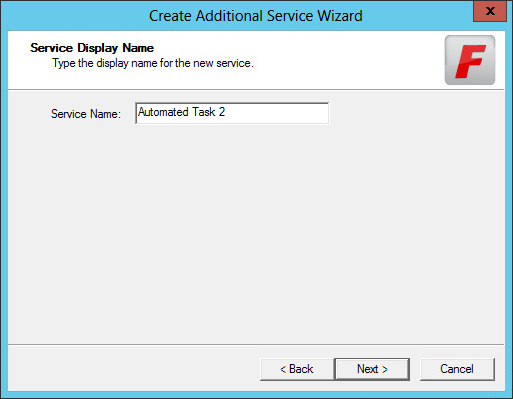
- In the Local data directory field, type the path of the prepared directory where local data can be stored and click “Next”.
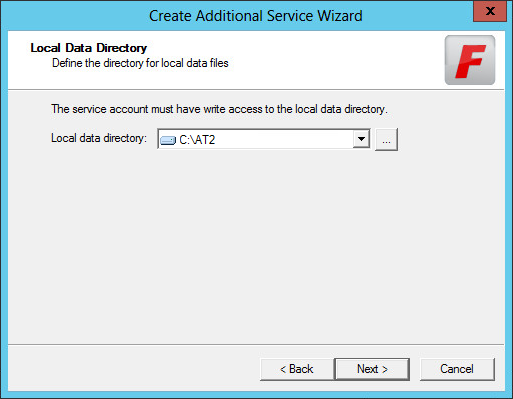
- A summary of the settings is displayed. Click “Next”.
- An additional Fabasoft Folio AT Service was installed. Click “Finish“.
In the Fabasoft Folio Server Management navigate to “Fabasoft Folio“ > “Computers“ > “<computer name>” > “Automated Tasks”. An additional Fabasoft Folio AT Service is available. It is stopped by default.
Start a Fabasoft Folio AT Service
Manual Start
To start a Fabasoft Folio AT Service, perform the following steps:
- Run the “Fabasoft Folio Server Management”.
- Navigate to “Fabasoft Folio” > “Computers” > “<computer name>” > “Automated Tasks”, to display all Fabasoft Folio AT Services.
- Right-click the Fabasoft Folio AT Service you want to start and click “Start Service”.

The Fabasoft Folio AT Service is running.
Automatic Start
To start a Fabasoft Folio AT Service automatically when starting the operating system, perform the following steps:
- Run the “Fabasoft Folio Server Management“.
- Navigate to “Fabasoft Folio” > “Computers” > “<computer name>” > “Automated Tasks”, to display all Fabasoft Folio AT Services.
- Right-click the Fabasoft Folio AT Service you want to start and click “Properties”.
- Select Autostart service when the operating system starts and click “OK“.
The Fabasoft Folio AT Service is started during each start of the operating system.
Processing Automated Tasks
Prerequisites this Chapter is Based on
The following prerequisites have to be fulfilled for processing tasks in the background.
Prerequisites in the System Environment
- The Fabasoft Folio/AT software product has to be installed and a Fabasoft Folio AT Service has to be set up.
- The user for which the Fabasoft Folio AT Service has been set up needs to have launch permissions for the “Fabasoft Folio AT Server“ application.
Prerequisites in the Fabasoft Folio Domain
- The user for which the Fabasoft Folio AT Service has been set up needs to have a user object in the Fabasoft Folio Domain.
- The user object of the user, for which the Fabasoft Folio AT Service has been set up needs to have a user environment (or a Default Environment Template).
Note: If the Fabasoft Folio AT Services have been installed at the same computer as the Fabasoft Folio Backend Services and the same user has performed the installation, the prerequisites in the Fabasoft Folio Domain are fulfilled automatically.
Settings for Processing Automated Tasks
The following settings have to be made to process automated tasks:
- Open the properties of the user object of the user in whose context the automated tasks should be processed in edit mode. On the “Workflow” tab of the User, in the Executes Activities in the Background dropdown list select “Yes“.
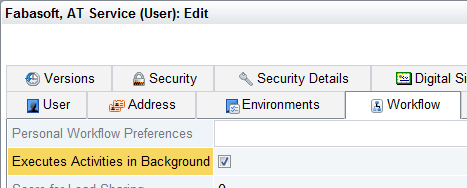
- In the Current Domain, on the “System Configuration” tab, the user object has to be entered as privileged user, so that an automatic change of the user context is possible for that user.

Note: If the Fabasoft Folio AT Services have been installed at the same computer as the Fabasoft Folio Backend Services and the same user has performed the installation, this setting is done automatically.
List of Automated Tasks and Automated Tasks
List of Automated Tasks
When starting a Fabasoft Folio AT Service it is checked whether for the user in whose context the Fabasoft Folio AT Service is running an object of the object class List of Automated Tasks is available.
- If in the User object on the “Advanced” tab in the List of Automated Tasks dropdown list a List of Automated Tasks object has been deposited, the contained tasks are processed, even if the user in whose context the Fabasoft Folio AT Service is running is not the owner of the List of Automated Tasks object.
Note: If the Fabasoft Folio AT Services have been installed at the same computer as the Fabasoft Folio Backend Services and the same user has performed the installation, a List of Automated Tasks object is created and deposited automatically. - If in the User object no List of Automated Tasks object has been deposited, then the Fabasoft Folio Domain is searched for an object of the object class List of Automated Tasks with the user in whose context the Fabasoft Folio AT Service is running as Owner. In this case the tasks contained in this List of Automated Tasks object are processed.
- If in the User object no List of Automated Tasks object has been deposited and in the Fabasoft Folio Domain no object of the object class List of Automated Tasks with the user in whose context the Fabasoft Folio AT Service is running as Owner is available, a new List of Automated Tasks object is created and processed.
To localize a List of Automated Tasks object created automatically, perform the following steps:
- In the Domain Administration, navigate to the User Objects and click the “List Automated Tasks” tab.
- On the “Edit” menu, click “Refresh“.
Now you can edit the properties of the List of Automated Tasks object and for example insert an Automated Task.
The following properties are available when editing a List of Automated Tasks object:
- Tasks
In this property, objects of the Automated Task object class can be specified. An object of this object class defines a task that is processed by a Fabasoft Folio AT Service. By means of an Automated Task it can be specified, at which time which action is processed on which object. - Maximum Number of Threads
This property is used to define, how many threads are reserved in the Fabasoft Folio AT Service for processing tasks. If only one thread is used, the tasks are processed sequentially. - Maximum Run Time (min.)
This property is used to define, how long system resources are allocated to a task. If a task crosses this time limit, the priority of this thread is decreased (to BELOW_NORMAL). Thereby for this thread less system resources are needed. If necessary, a new thread is assigned to the thread pool. - Wait for Lock (sec.)
Adding a new task to the task list, the task list has to be locked during this space of time. But if a task wants to create a new task and the task list is locked due to a similar operation, the Fabasoft Folio AT Service tries repeatedly to get the lock for the Automated Tasks object.
The Wait for Lock (sec.) property is used to define, how long a Fabasoft Folio AT Service should try to set a lock before an error message is displayed. - Restart after (min.)
This property is used to define after which time the Fabasoft Folio AT Service tries to start again if it is not available. - Resources
This property can be used to assign tasks to resources. A queue for the Fabasoft Folio AT Service and thus the sequence for processing the tasks can be defined.
By default a resource uses the same values as the standard queue (Maximum Number of Threads, Maximum Run Time (min.), Restart after (min.)), but this values can be overwritten per resource.
Automated Task
An object of the object class Automated Task defines a task which is processed by a Fabasoft Folio AT Service in the background. Each Automated Task has to be deposited in the List of Automated Tasks object.
When a Fabasoft Folio AT Service is started it is checked automatically, whether the Check list of background activities task is available in the Tasks field of a List of Automated Tasks object. If not, this task is created automatically. It regularly checks the Fabasoft Folio Domain for background activities which are processed.
To create an Automated Task, perform the following steps:
- In the Domain Administration, navigate to the User Objects. Click List of Automated Tasks and open an object of object class List of Automated Tasks.
- Click “Object” > “New” > “Next” and click “Properties”.
- In the Start on/at field, type the time when the task should be started. In the Object dropdown list select an object, on which the action selected in the Action field should be executed.
- Click “Next“.
The following properties are available when editing an Automated Task object:
- State
In this field, the current state of the task is displayed.- ”Finished” is used to temporarily deactivate the automated task.
- “Activated” is used to (re)activate the automated task.
- ”Running” means that the automated task is currently processed.
Note: This value cannot be selected when editing an Automated Task object. - ”Disabled” means, that the automated task has been interrupted, e.g. because the processing time limit has been crossed.
- Start on/at
In this field, the time when the task should be processed can be defined. - Object
In this dropdown list, the object is defined, on which the action selected in the Action dropdown list should be executed.
Note: The user in whose context the Automated Task is processed needs to have read or edit permissions on the object defined in this dropdown list, depending on the action which is executed on the object when the task is processed.
If in the scope of processing the Automated Task further objects are read or edited, the user also needs to have the necessary permissions on these objects. - Action
In this dropdown list, the action which should automatically be executed on the object selected in the Object dropdown list is selected.
Note: It is required, that actions for automated tasks can be processed in the background. Thus the appropriate methods must not display dialogue boxes waiting for user input. - Resource
In this dropdown list, a resource can be selected. If you do not select a resource, the task is added to the standard queue of the Fabasoft Folio AT Service.
Note: If a resource is defined in this dropdown list, the queue of the Fabasoft Folio AT Service will be designated as defined in the Resources box in the List of Automated Tasks object. - Repetition
Automated tasks can be processed periodically. For this purpose, in this field a value can be defined. - Repetition Type
This dropdown list is used to define, how the value of the Repetition box will be interpreted. If for example “Minutes Delay” is selected as Repetition Type and “2“ is typed in the Repetition field, the Automated Task is processed in a delay of two minutes. The following options are available:- “Never Repeat”: The task is only processed once.
- “Minutes/Hours/Days/Weeks/Months After Ending”: The task is processed in an interval of the selected unit. The end time of the last process defines the start time of the next iteration.
- “Minutes/Hours/Days/Weeks/Months After Start”: The start time for processing the task again does not depend on the endurance of the last processing, but depends on the point in time defined in the Start on/at field.
- Restrict to weekdays
This dropdown list allows to define on which weekdays the automated task should be processed. - Automatic Delete
In the Automatic Delete dropdown list, the life time of the Automated Task object is defined. An Automated Task can for example be deleted after finishing. The following options are available:- ”No Automatic Delete“: The Automated Task is not deleted automatically.
- “Delete Successfully Finished Task“: The Automated Task is only deleted if processing the action of the task returns an error. If an error occurs, the state of the task is set to “Finished“ and the task stays in the task list.
- “Delete Finished Task After Error“: The Automated Task is only deleted, if processing the action of the task returns an error. If no error occurs, the state of the task is set to “Finished” and the task stays in the task list.
- “Delete Finished Task“: The Automated Task is deleted, regardless of the result of the action. The task is not deleted immediately after finishing but after a short time removed from the task list. Periodical actions are not deleted automatically.
- Configuration for History
In the Configuration for History field, logging can be configured for processing the Automated Task. The following options are available for logging:- “No Log”
- “Log Errors”
Note: Errors are also logged in the Microsoft Window event viewer. As source the identifier (Fabasoft Folio AT) of the Fabasoft Folio AT Service is displayed. - “Log Successful Runs”
- “Log Every Run”
- Maximum Number of History Entries
In this field, the maximum number of entries displayed in the History field is defined. - History
In this field, log data of processing the Automated Task is displayed according to the selection in the Configuration for History field. - Maximum Run Time (min.)
In this field, the maximum run time for processing a task is defined. If the task is not completed within this time span, the priority of the thread processing the task is decreased (to BELOW_NORMAL). In this case, the state of the task is set to “Deactivated”. For processing the task again, the state has to be set to “Waiting” manually. In the case of exceeding the specified run time, a new thread is assigned to the resource pool. So the resource again possess the configured number of threads.
Note: The value defined in this field overrides the value in a task list (in the object of the object class List of Automated Tasks).
Process
If a Fabasoft Folio AT Service is started, it logs on to the Fabasoft Folio Domain with the configured user account. The Fabasoft Folio AT Service searches for a task list of the user (CooRuntime::GetCurrentUserRoot()). The tasks contained in the task list are processed as configured.
The task list is defined via an object of the object class List of Automated Tasks. Which List of Automated Tasks object is processed is described in chapter “List of Automated Tasks”. The List of Automated Tasks object is checked for changes every 15 seconds. In case of a modification (e.g. a task has been added), the task list is evaluated and searched for tasks to be processed. Without modification, the task list is evaluated every 60 seconds. If an error occurs during the evaluation of the task list, log data can be found in the Microsoft Windows event viewer.
Note: Processing automated tasks, access rights are checked.
